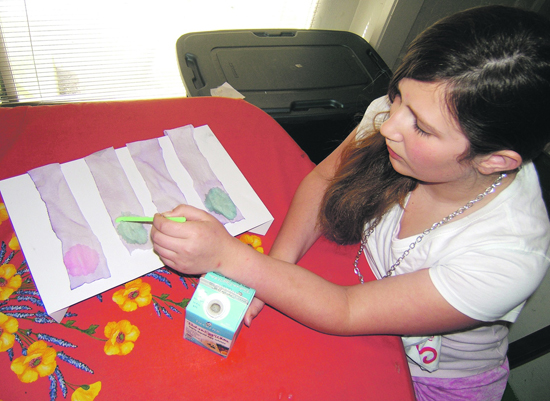 | | | Reluctant scientist Ava Tajbakhsh discovers that vinegar is a strong acid
and egg white is a strong base. Photo Lee Borrowman
| | | | | | Acids and Bases sound like very scientific terms, but you can find acids and bases all over your house. What makes something acidic or basic has to do with its chemical formula, and is a bit hard to explain here, but we can detect weak acids and bases with our senses. Acids typically taste sour, or tangy. Citric acid is a weak acid that is safe enough to eat and is used in most sour candy. Bases tend to feel slimy. Bar soaps are usually weak bases. The stronger the acid or base is, the more dangerous it is. CAUTION: Some acids or bases can burn your skin, or be dangerous to eat. Here is an experiment that will help you determine what is acidic and what is basic in your kitchen.
 1.Gather these supplies:
1.Gather these supplies:
 Red Cabbage
Red Cabbage
 Strainer
Strainer
 Coffee filters or strong
Coffee filters or strong
 strips of paper towel.
strips of paper towel.
 Blender
Blender
 Knife
Knife
 Toothpick or eyedropper
Toothpick or eyedropper
 Various liquids to test
Various liquids to test
 (vinegar, milk, baking soda
(vinegar, milk, baking soda
 mixed in water, etc.)
mixed in water, etc.)
 2. Start your experiment:
2. Start your experiment:
 Chop up the cabbage small enough to fit into your blender. Put it in the blender and add just enough water to cover it. After blending, strain it and save the liquid, which will be purple. Cut up the coffee filters or paper towels into strips and dip them in the cabbage juice. Let them dry. Now use the eyedropper or toothpick to put drips of your test liquid onto the dyed strips.
Chop up the cabbage small enough to fit into your blender. Put it in the blender and add just enough water to cover it. After blending, strain it and save the liquid, which will be purple. Cut up the coffee filters or paper towels into strips and dip them in the cabbage juice. Let them dry. Now use the eyedropper or toothpick to put drips of your test liquid onto the dyed strips.
 3. What happened?
3. What happened?
 The cabbage juice acts as an indicator. The paper turns a different color depending on whether the liquid is an acid or a base. Acids will turn the paper different shades of pink. Bases will turn it blue to green. Acids and Bases are assigned numbers depending on how strong they are. The number scale ( called pH) goes from 1-14, with a really strong acid like muriatic acid (used in swimming pools) at the 1 -end. Lye is a really strong base used in making soap, and is at the 14 end. Scientists use this logarithmic scale of numbers when they want to show a lot of difference between items. Each number in this logaithmic scale represents a strength ten times the last number. So an acid with a pH of 2 is ten times stronger than an acid with a pH of 3. You can make your own pH scale using the pH of a known substance, one that you can find on the internet. For example the pH of lemon juice is about 2 and the pH of ammonia water is about 11. Using these two numbers, you can arrange the colors of your indicator paper in between from brightest pink to brightest green. Try testing and guessing the pH for these items: milk, orange juice, water, and eggs.
The cabbage juice acts as an indicator. The paper turns a different color depending on whether the liquid is an acid or a base. Acids will turn the paper different shades of pink. Bases will turn it blue to green. Acids and Bases are assigned numbers depending on how strong they are. The number scale ( called pH) goes from 1-14, with a really strong acid like muriatic acid (used in swimming pools) at the 1 -end. Lye is a really strong base used in making soap, and is at the 14 end. Scientists use this logarithmic scale of numbers when they want to show a lot of difference between items. Each number in this logaithmic scale represents a strength ten times the last number. So an acid with a pH of 2 is ten times stronger than an acid with a pH of 3. You can make your own pH scale using the pH of a known substance, one that you can find on the internet. For example the pH of lemon juice is about 2 and the pH of ammonia water is about 11. Using these two numbers, you can arrange the colors of your indicator paper in between from brightest pink to brightest green. Try testing and guessing the pH for these items: milk, orange juice, water, and eggs.

|
